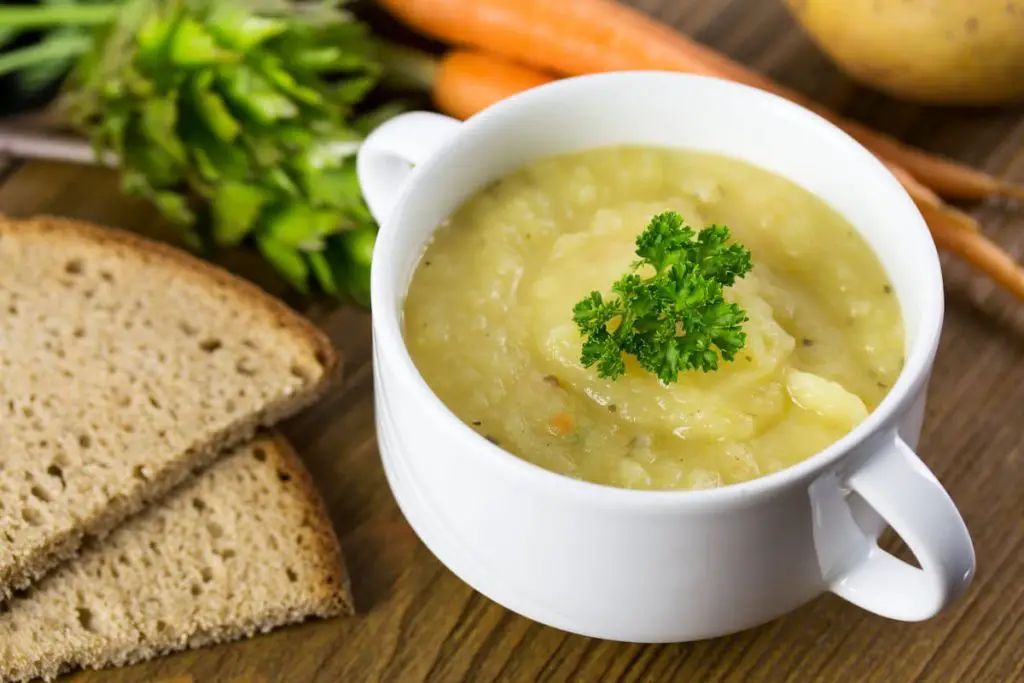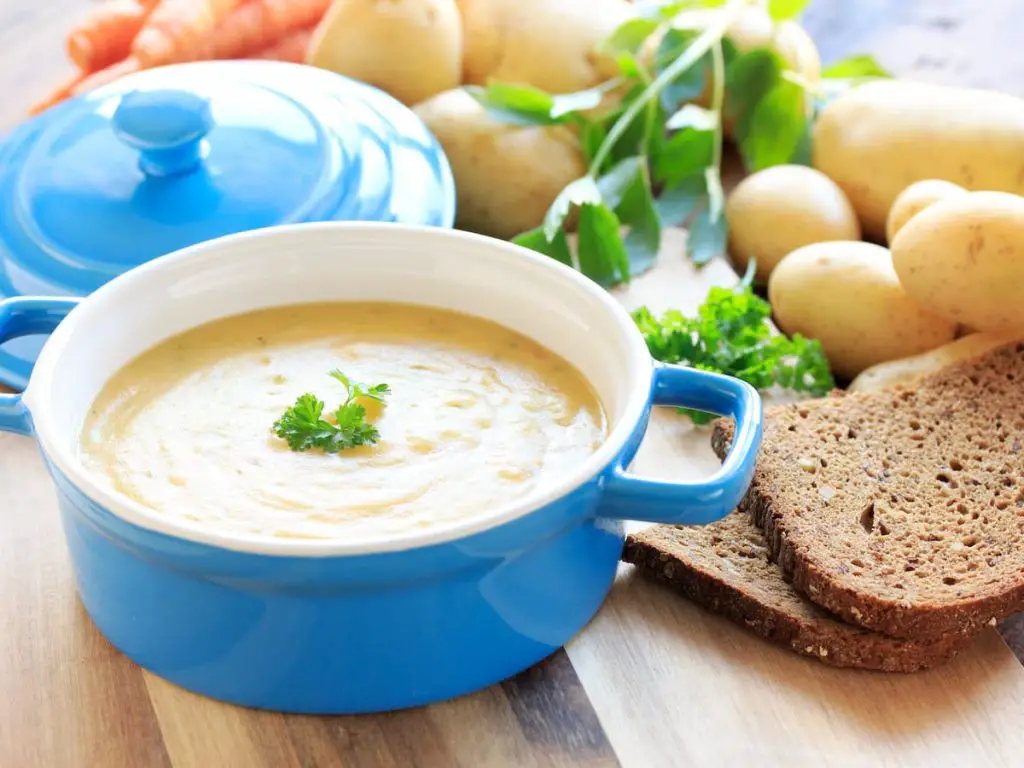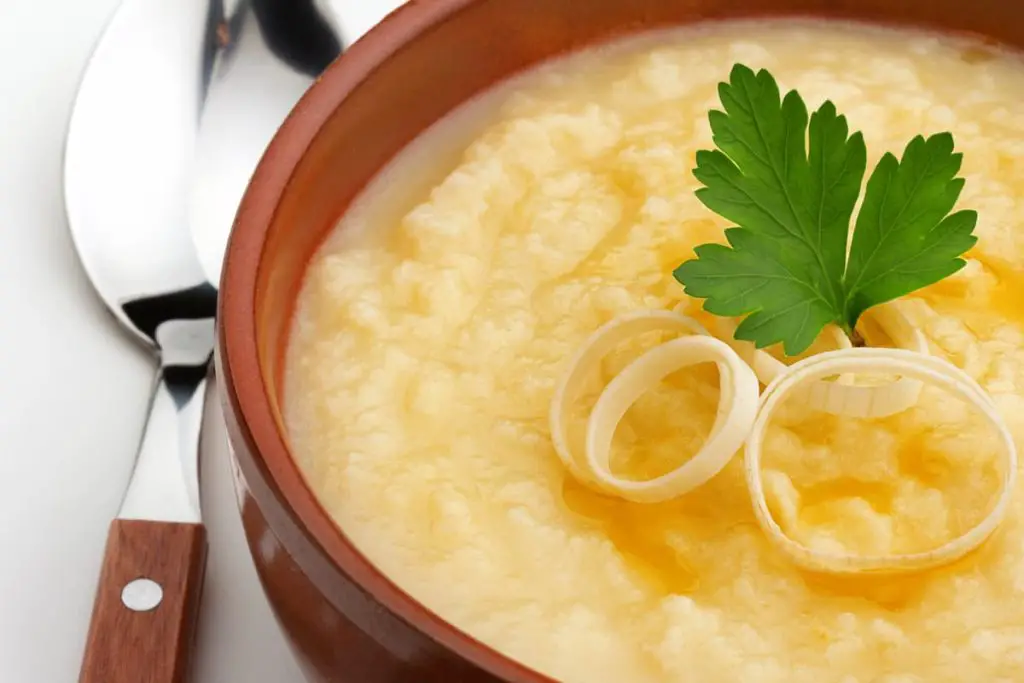Freezing Potato Soup: Do You Really Want To? (Explained)
On a chilly day, one can never go wrong with a bowl of hot and creamy potato soup. It’s one of the best comfort foods out there. However, is it possible to freeze it if you make too much?
You can freeze potato soup, but it’s not one of the best soups to be frozen. During freezing, the potatoes absorb moisture leaving the soup dry. Water and fat separate when defrosting, making the soup grainy. Cream-based potato soups tend to also lose their creamy consistency after freezing.
There are better ways to prepare and freeze potato soup without being disappointed. Read along to discover more about freezing potato soup.

Is It Possible To Freeze Potato Soup?
Though it’s hard to freeze potato soup compared to many other food items, there are a few things you can do to ensure it gives the same creamy taste after reheating.
It is possible to freeze potato soup. However, it may not give the best result if thawing isn’t done right. After freezing any dish containing dairy, water and fat will separate, leaving the soup a bit grainy when thawing or reheating.
Here are a few tips you can use to ensure you still enjoy the same consistency and creamy taste in your potato soup after freezing:
- Instead of potato chunks, consider using potato puree. Although potato pieces make delicious potato soup, they don’t freeze as well as pureed potatoes.
- Don’t add cream while cooking potato soup if you plan to freeze some. Don’t add cream at this stage. Instead, once you’ve defrosted it, put some cream in while reheating.
- Omit seasoning ingredients when cooking potato soup with the purpose of freezing. Freezing fresh herbs and other seasoning spices could damage their flavor and purpose.
How Best To Freeze and Thaw Potato Soup
There’s a need for planning and preparation before freezing potato soup, especially when making chunky potato soup. While others love their potato soup all soft, some prefer potato soup with chunks of potatoes and vegetables.
Anyone who loves their potato soup smooth doesn’t need to plan ahead or take any precautions when cooking.
However, planning is vital before freezing potato soup when making the chunky type with whole vegetables.

Prepare Chunky Potato Soup Before Freezing
Depending on the recipe, when the potato soup is 75% done, remove it from the heat to allow cooling.
Letting this soup cook to a 100% completion will make the vegetables and potato pieces overcook when reheating after thawing. So, to avoid overcooking later and interfering with the taste and flavors of potato soup, it’s better to leave it slightly undercooked.
After separating a portion to be frozen, you can continue cooking the part you’re ready to eat now to completion.
Freezing Potato Soup
The explanation in this section applies to both soft and chunky potato soups.
As stated above, the potato soup needs to cool down before storing it in the freezer. Therefore, set the soup aside to allow cooling after cooking. Exercise patience here since allowing such a thick soup to cool down may take a couple of hours.
Speeding the cooling process is possible if one isn’t patient enough. After adding it to a container and sealing it well to avoid spilling, transfer the container to a cold bath or a pot of ice.
Once cooled, open or remove the container seal and divide this soup into smaller freezer bags or containers. Dividing the soup into smaller containers before freezing enables easy and quick thawing whenever you want to eat.
Defrosting all the potato soup kept in one large container will undoubtedly take time. Additionally, the leftovers will become a waste since it isn’t safe to thaw potato soup and then put it back in the freezer again.
Dividing this soup into smaller portions also helps in saving space in the freezer.

Here are a few helpful notes about freezer bags should one choose them over containers to store potato soup.
- Adding potato soup to freezer bags can be messy if one is not careful.
- Don’t fill up the freezer bag fully to allow potato soup to expand when freezing.
- Press out excess air before sealing the freezer bag completely.
- Label and add the date on the bag for easy reference. Doing so will help you know how long the soup has been frozen.
The best thing about freezer bags is that they can easily lay flat in the freezer stacked on top of one another, thereby saving space.
Now that the freezer preparation is over, it’s time to store this potato soup in the freezer, packed in either Ziploc bags or freezer-safe containers.
If using Ziploc bags, lay them flat in the freezer for about two hours or until it freezes solid. Once frozen, it will be possible afterward to stack other foods on top. Another option is to stand the bags up to save space in the freezer.
Thawing and Reheating Potato Soup
Transfer the stored potato soup from the freezer to the refrigerator overnight or for several hours. This is the best method to use in thawing potato soup.
However, there are several potato soup thawing options if only a few hours are left until dinner:
- Put the potato soup in a bowl of warm water or a sink under running water. Ensure the freezer container or bag is still sealed to avoid spilling during thawing. This option will reduce the defrost time, but it still takes a bit of time to defrost thoroughly.
- Another alternative is to pour the soup into a pot to warm slowly on low heat. While warming, keep constantly stirring to combine all the ingredients. At this stage, depending on what the recipe calls for, add spices, fresh herbs, and cream to make the potato soup creamy and flavorful.
- The last potato soup thawing option is using a microwave. This option is only recommended for soft potato soup. The potato chunks or vegetables in the chunky potato soup may turn mushy if thawed using a microwave. After defrosting the soft potato soup, transfer it to a pot for reheating. Add spices and cream depending on the recipe used for cooking.
Also, if you didn’t fully cook the potato soup the first time, you’ll need to add some additional cook time to allow the potatoes and vegetables to finish cooking completely.
How Long Should Potato Soup Last in the Freezer?
Potato soup can last up to six months in the freezer. The freezer’s temperature must be 0ºF (-17ºC) or lower. If stored for prolonged periods in the freezer, the potato soup will still be safe for consumption, but its quality, taste, and texture will likely deteriorate.
Unlike in the freezer, potato soup can only last three to four days when stored in the refrigerator. An extra day and the soup isn’t safe for consumption.
The longer potato soup stays in the freezer, the more its taste and quality deteriorates. It’s even worse for chunky potato soups since the potato pieces can turn mushy, ruining the texture.
This soup may still be safe to eat, except for its texture and low quality. So, how can one tell if the frozen potato soup has gone stale?
How Can You Tell if Frozen Potato Soup Has Gone Bad?
You can tell if the frozen soup has gone bad by physically examining it. Check if mold is growing on it or if you can smell a strange odor coming from the soup. Discolorization, freezer burns, and foul odor indicate the soup has gone stale.
Discoloration and freezer burns on the frozen potato soup are primary indicators that the soup isn’t safe for consumption.
However, if there are no such signs, you can also wait for the potato soup to thaw and reheat before tasting to determine if it’s gone bad or not.
Final Thoughts
You can freeze potato soup as long as you do it right. When cooking potato soup with the intention to freeze, don’t add cream or any dairy product when cooking. You can do so after thawing when reheating to eat.




